You’ve probably clicked on an Instagram video or a Facebook post or even a Google search result, only to notice later that it’s an ad. Online advertising has evolved to be contextual, hyper-specific, intelligent, relevant, and helpful.
Whether it’s a search result that pops up on Google, or a retargeted Facebook ad urging you to complete your purchase instead of leaving the shopping cart empty, internet advertising is everywhere. And in this article, we will break it down for you.
We will cover everything you need to know about online advertising including its importance, the platforms you can use, and the best strategies you can use for your brand. Click on the links below to navigate to a specific section:
A. Why do you need to advertise online?
B. What are the different types of online advertising?
C. 7 Best online advertising strategies to use for your brand
Pro tip: Videos are a key component of online advertising and you can start creating video ads quickly and easily by signing up for a free account on InVideo.
A. Why do you need to advertise online?
Ecommerce sales are expected to grow by 50% from 2021 and reach $7.4 trillion by 2025. One of the key components facilitating this increase in sales is online advertising.
With 4 billion people using the internet today, the competition for brands and businesses is fierce, thereby increasing the need for attention-grabbing ads that help your brand stand out. Otherwise, how do you expect to get noticed in a sea of online content — everywhere from search engines to social media platforms? Keeping this in mind, here are a few reasons you should use online advertising for your brand:
- To raise awareness of your brand: You can spread the word about your brand beyond your physical community. You are no longer restricted by location and can reach a global audience.
- To drive potential customers to your business: You can specifically target people who have the highest chance of buying your product. Simultaneously you grow your understanding of the target audience and get a deeper analysis of the way potential customers interact with your product.
- To promote sales for both new and existing products: You can simultaneously promote multiple products. This is a huge leap as compared to traditional advertising channels where you could only focus on one product or service at a time.
- To introduce a new product or service to the market: You want to get all the buzz you can get when you are launching a new product or service in the market. Online advertising is the easiest way to generate that buzz.
As compared to any other advertising channel, online advertising allows you to get one of the greatest returns on investment because it is low-cost and removes the location barrier completely.
Now, let’s take a look at the different types of channels of online advertising to help you move in the right direction.
B. What are the different types of online advertising?
Online advertising can take many forms depending on your marketing and sales objectives. For instance, if you’re a shoe brand and want to target the local people in the area wanting to buy shoes, you should go for paid search ads because you then get to tap into that search volume for shoes. Similar to this, other objectives will require you to run other types of ads. But what are all these types? We will be discussing the following popular online advertising channels in detail:
1. Paid search advertising
2. Native advertising
3. Display ads
4. Social media ads - Facebook, Instagram, Twitter, YouTube, TikTok
Let’s explore these in-depth:
1. Paid search advertising
Search engines like Google, Yahoo, and Bing allow you to run paid ads for certain keywords (known as bidding) so that you can appear on top of the search results when someone searches for the specific keyword you’re targeting. This is often referred to as PPC or pay-per-click advertising because it charges the advertiser for every click the ad receives.
The idea behind this is that people who search for a specific keyword on a search engine often click on the first result they see. This is a great opportunity for marketers as ads are displayed above organic search results on the search engines results page (SERPs). For example, when I search for the best restaurants in Seattle, the first few Google search results are all ads.
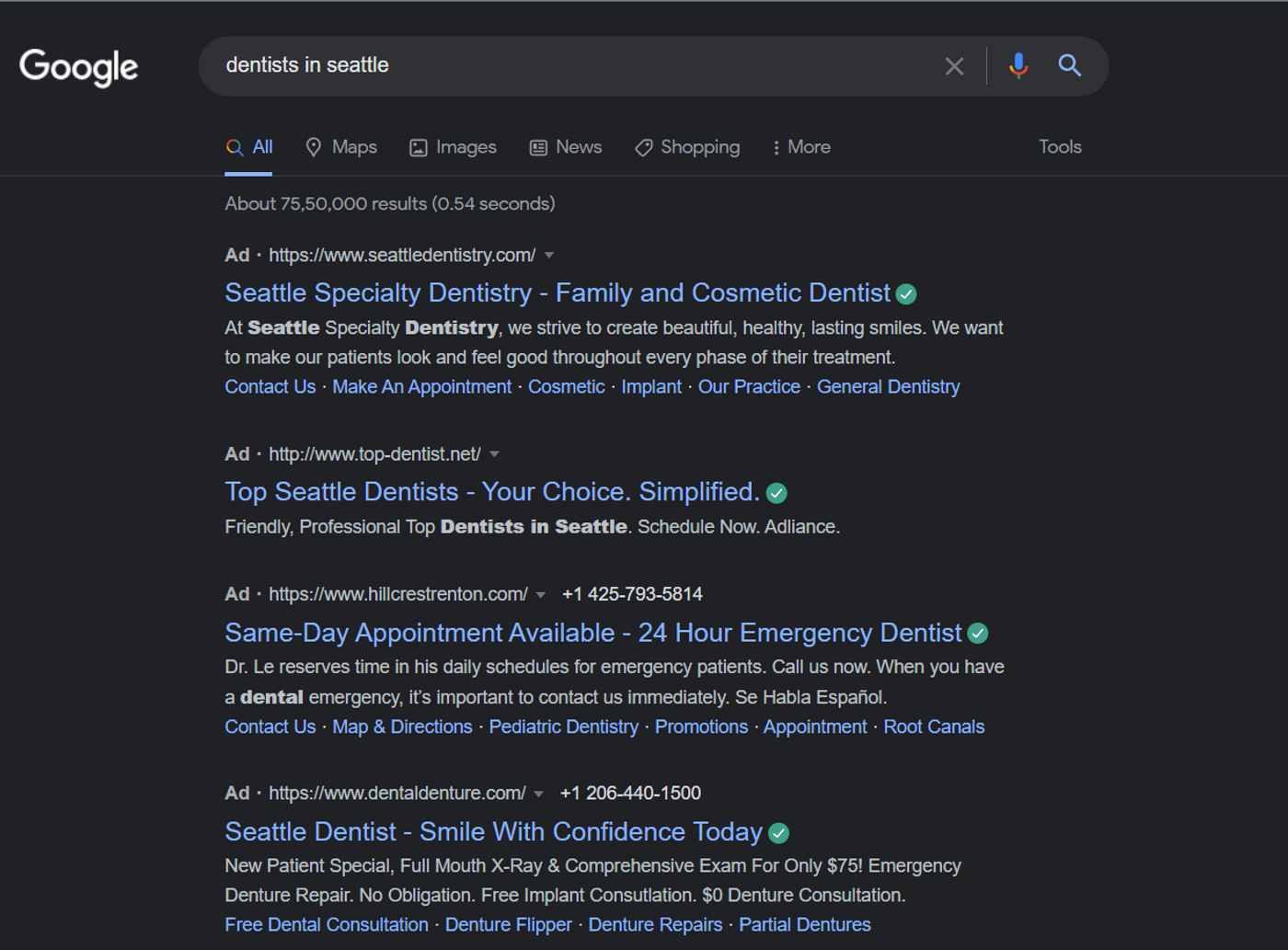
Paid search ads let you cater to the wants and needs of your target consumers in a very contextual and intelligent way. Plus analyzing your ads over a period of time can help you improve your reach and targeting. According to a Google report, brands that include online advertising in their strategy can expect four times better revenue compared to the ones that don’t.
Apart from Google, other popular search engines include YouTube, Bing, Amazon, Facebook, Microsoft Bing, Baidu, and Yandex. While other search engines are popular, Google Search tops the chart with over 84% of the search market share.
If you are just getting started with PPC ads or paid search ads, you want to start with Google Ads. Here are a few steps to help you along:
Step 1: Keyword research
Keywords are the starting point for all paid ads because these are building blocks that a search engine works on. All of us type or speak words into search engines when we are looking for something. All these words are keywords for the advertising marketer. Some tips for selecting keywords include:
- Check out what keywords your competition is using.
- Think like a customer and figure out what possible keywords they would type for your brand to show up in the search.
- Use tools like Google keywords, Moz, and SEMrush to find relevant keywords in your niche, market, etc.
- Use specific, long-tail keywords rather than generic ones.
- Use local keywords and location based keywords if relevant and possible.
All these different ads that Google shows you are based on keywords you enter in the search query. Check out more about how you can select the right keywords for your ads in this article.
Step 2: Determine your goal
What do you plan to achieve with your ad campaign (sales, brand awareness, leads, repeat sales, product or brand consideration, etc.). These goals align with the basic sales funnel: awareness, consideration, and purchase. Depending on your brand sales funnel, you can determine the right goals for various ad campaigns.
Step 3: Set a budget
A PPC budget is how much money is committed to online traffic acquisition efforts since advertising charges only accrue after a prospect clicks on your ad. So, what should the monthly amount be? Check out this video to understand how you can determine your Google Ads budget:
Step 4: Determine your bidding strategy
Bidding comes into the picture when you want to select specific keywords for your Google Ads. A bid is basically the amount of money you are willing to spend for a single click on a keyword in Google Ads. Your bids will dictate where your ads show up in search results.
According to Google, you have several ways to bid for your ads, depending on what matters most to you and your business. Most advertisers focus on clicks, impressions, conversions, or views (for video ads). Check out the basics of bidding here or learn some detailed bidding strategies in this video.
Finally, after all these steps, it’s time to create your ad and launch it. Check out this detailed video to help you start your very first Google Ads campaign, step by step.
Pro Tip: Creating video ads can help you rank better for search terms and also help boost brand awareness. To create stunning, professional video ads in minutes, sign up for InVideo’s video ad maker and get started for free.
2. Native advertising
Ever read an article that turned out to be an ad? Then you’ve experienced native advertising. This type of advertising often refers to ads in an online publication or video that resembles their editorial content but is paid for by an advertiser with the intent of promoting their product or service.
Such native ads are super popular on websites such as Forbes, New York Times, Buzzfeed, and others. This type of advertising is rooted in the philosophy that these publications get a lot of organic reach on their content and can therefore help brands mirror that reach by renting out editorial space for ad revenue.
For example, the New York Times native advertising arm T Brand Studio has produced some beautiful native ads that received as much reach as their organic content. Check out this post they did on Pointe Shoes by Grit & Grace.
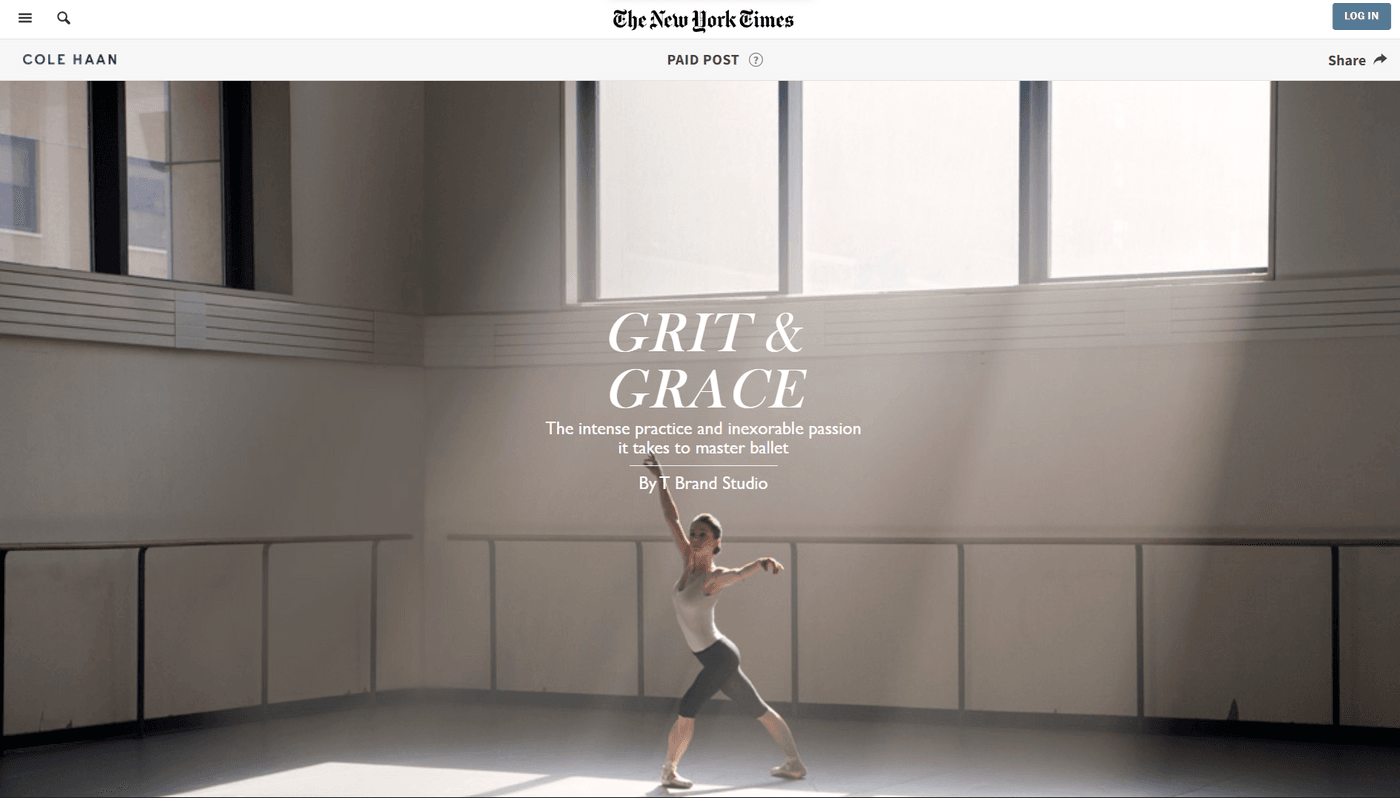
Written and laid out beautifully, this post does not read much like an ad. It looks and reads like a regular NY Times feature post, except that it is a paid ad. Find out how you can get started on your own native advertising journey in this informative video guide.
While the most common form of this type of advertising is paid media articles, one other way that brands use native advertising is by way of sponsored video content. Sponsored posts on YouTube, Instagram and other video platforms are an example of this.
Pro Tip: If you are looking to create sponsored video content quickly and easily, consider signing up for InVideo, where you get access to a robust editor, thousands of templates, stock assets, and more to create stunning video content in minutes.
3. Display ads
Up until a few years ago, this used to be the most popular form of advertising on the web. Display ads refer to the ads that get displayed on web pages that you visit either on one side or above or below the text. For instance, all the various ads you see on this page are display ads. These can be banner ads (on top of the page), skyscraper ads (on the sides of a page), or even pop up as video ads across the page in some cases.
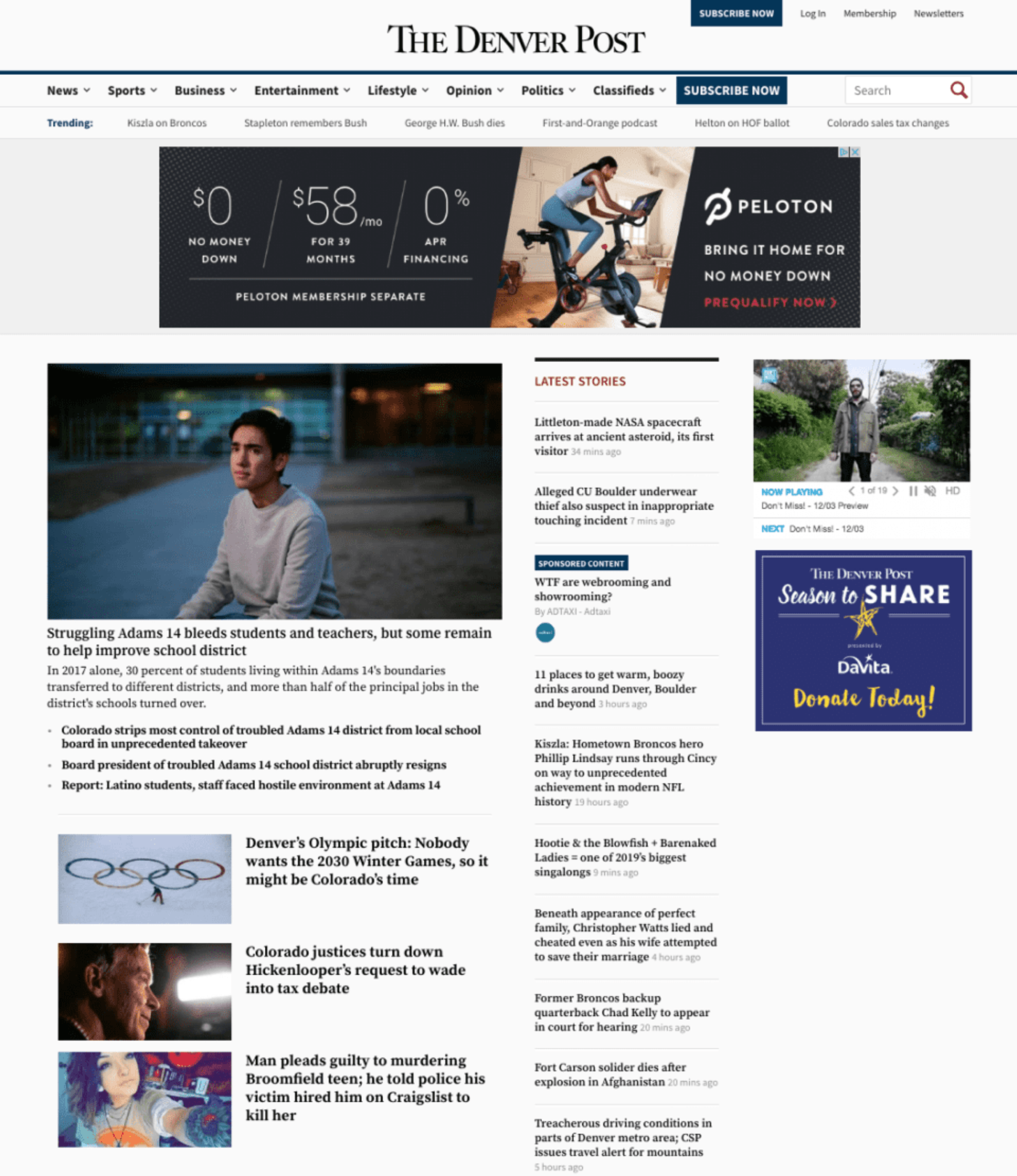
For years, display ads have been somewhat controversial. Ad blockers are installed on browsers just to deal with these. Despite their reputation, however, display ads continue to be popular with advertisers because they have the power to show consumers highly targeted content.
The 2 ad networks that are most commonly used today to include:
1) Google display network
Ads created on Google display network can be beautifully crafted and placed across over two million websites and apps, YouTube, and Gmail. You can build new targeted audiences quite easily on the Google display network by simply importing a list of their information. This allows you to remarket your product or service to a highly interested audience easily. Google display ads are great for retargeting users who are already familiar with your brand. Check out this guide to Google ads to understand how best you can use the Google display network.
2) Facebook’s audience network
Brands that are a part of the Facebook audience network can expand Facebook campaigns and advertise across a huge collection of websites and apps connected to Facebook. In fact, brands can use the same targeting data to drive the relevant kind of engagement across websites and apps. These ads can be native, banner ads, full-screen ads, in-stream video ads, and reward video ads on Facebook audience network websites that their target users normally visit. You’ve probably seen these ads on mobile games, e-readers, and more. Check out how you can do more with Facebook display ads here.
4. Social media ads
From connecting with friends to being a part of a community of like-minded people to buying and selling, consumers use social media for everything under the sun. With 2.5bn people using Facebook, 330 Mn people using Twitter, and 1 Bn people using Instagram on a monthly basis, the sheer scale of social media usage should tell you about the importance of social media advertising.
But to hit the point home, here are a few benefits of social media advertising that you must be aware of:
- You can reach highly customized and specific as well as relevant target audiences across all social platforms using in-built targeting features.
- You have access to a bunch of different ad formats to advertise effectively.
- You can generate rich leads and drive revenue and sales.
We now take a peek at some of the most popular social media networks, including Facebook, Instagram, Twitter, YouTube, and TikTok. We'll cover the audiences and ad types available on each one.
A. Facebook
The audience targeting on Facebook is one of its best features for online marketers. You can target 3 major types of audiences on Facebook:
- Core audiences: this is based on criteria like interest, location, age, gender, etc.
- Custom audience: You can create a custom audience with specific features highly relevant to your brand. You can also get in touch with users who have interacted with your brand in the past,
- Lookalike audiences: You can create new audiences similar to your existing audiences to reach new users.
You can advertise on Facebook in different formats, including photo ads, video ads, story ads, and lead ads which are ads run with the purpose of generating leads. To get a better understanding of how to run Facebook ads for your brand, check out video on our channel:
While photo ads are a great way to share collections of images, product photos and more, you can create explainer video ads for greater engagement and reach. Story ads let you use photos and short form video. Lead ads meanwhile can be any of these ads above, but with a call to action asking the viewer or user to leave an email ID, contact details, and more. And you can create all kinds of video ads for Facebook using InVideo’s easy-to-use ad maker.
B. Instagram
With over one billion monthly users globally, Instagram is a must-use tool for online advertising. The majority of Instagram users are in the 18-34 age group, making it the place to be for millennial and Gen Z marketers alike. You can advertise on Instagram using the Facebook ads manager. On Instagram you can:
- Promote stories, posts, and reels straight from your Instagram business account
- Create ads from your Facebook Page and promote them on both Facebook and Instagram.
- Create ad campaigns in the Facebook Ads Manager to access full targeting capabilities
Besides the regular photo, video, and story ads, you can also create the following on Instagram:
- Explore page ads: These are ads created to help users discover products and services on the gram. They may often be linked to the Shopping ads page by a brand. Explore ads tend to reach new audiences
- Shopping post ads: These ads usually feature products being used or worn or explained, with a functionality to shop the product directly from Instagram. These ads come with a shop and price tag, enabling quick response from the viewer. For instance, check out this shop ad featuring couple watches by Olivia Burton London.
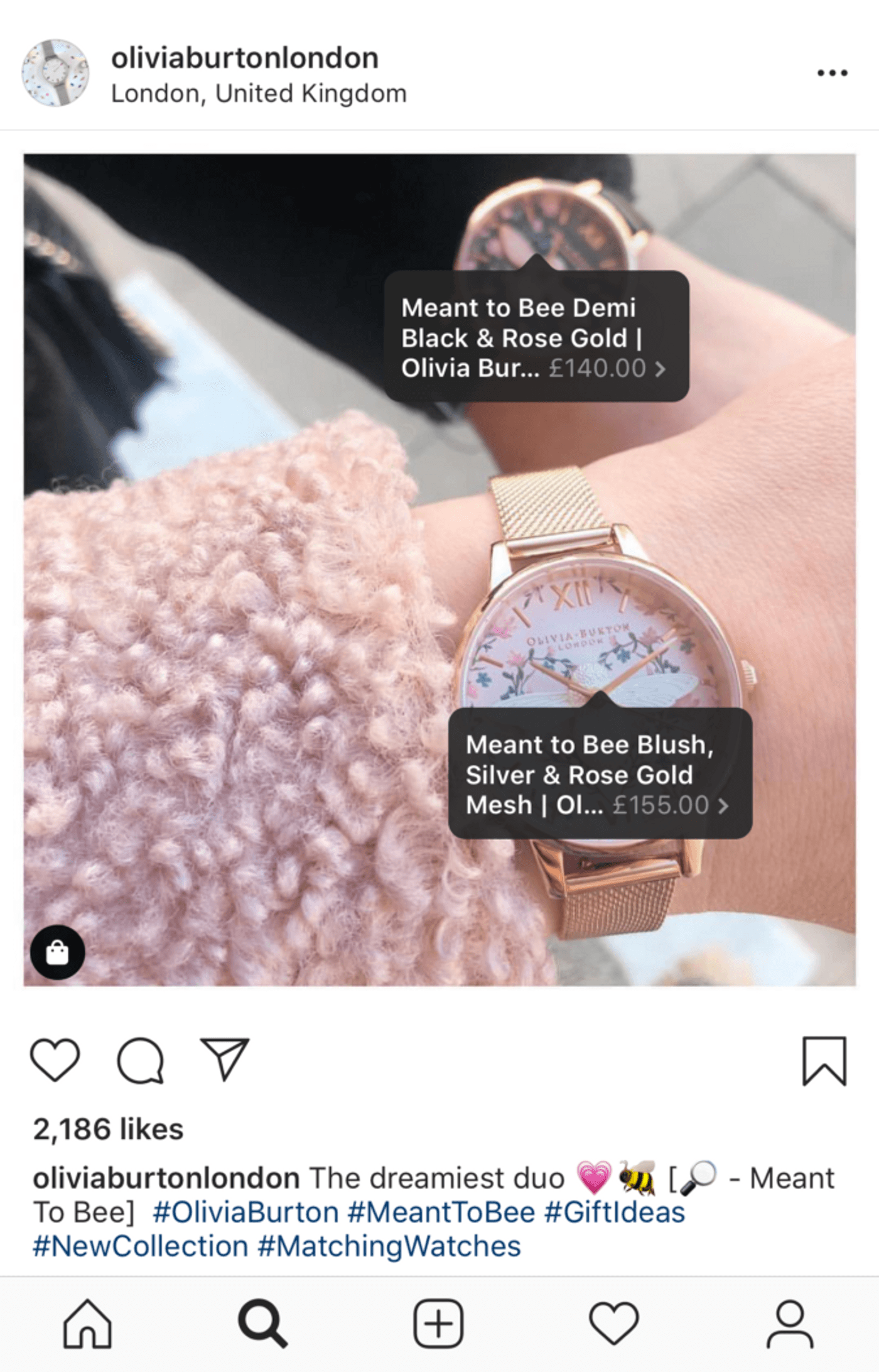
Creating Instagram ads involves creating posts and videos specifically tailored to different Instagram formats. For instance, a story ad needs to be in the 9:16 aspect ratio (vertical or portrait mode). Check out how you can get started with creating and running your Instagram ad campaign by following this detailed guide.
Pro Tip: You can create engaging, scroll-stopping video ads for Instagram in minutes using the InVideo Instagram Ad Maker.
C. Twitter
Organic reach is a hallmark of Twitter and so running ads on the platform needs to be thought out and hyper specific. With over 330 million monthly users globally, the majority of them between 35–65 years old, Twitter is slightly different compared to other platforms. Twitter is the place to advertise for B2B and eCommerce. For instance, check out this ad featuring Twenty20, a stock photo service. The ad/ tweet by Salesforce calling out businesses with a key benefit of their product. You can also see the “Promoted” tag denoting this is an ad.

Twitter ads are about 5 aspects:
- Creating awareness - this can be done through promoting B2B (or other) tweets.
- Tweet engagement - This involves promoting your tweets to get more likes, replies, retweets, etc
- Increasing followers - This involves promoting your brand account to increase reach and followers
- Increasing website click-throughs - This is simply promoting your website on Twitter to get more clicks
- Achieving app downloads - This involves promoting your app to get more downloads.
Creating ads on Twitter can be done through the Twitter ads manager. Twitter allows you to simply build ads using dozens of campaign goals and ad format types. Check out how Twitter ads work in this detailed video.
Pro Tip: Tweets with video get 10x more engagements than Tweets without video, which is why you should consider making short video ads for Twitter using InVideo's Ad Maker.
D. YouTube
With 2 Bn monthly active users, YouTube is the 2nd largest search engine in the world after Google. You’ve probably seen ads on YouTube before and after videos, or in between the videos. You may also see ads appear on YouTube after you search for something. YouTube ads are all video ads, and since YouTube allows targeting based on interest and demographics for their ads, you can ensure that your audiences watch content that is relevant to them. For instance, since I’ve been searching for tools for online and digital marketing while working on this guide, YouTube keeps showing me this LinkedIn ad when I fire up a video.
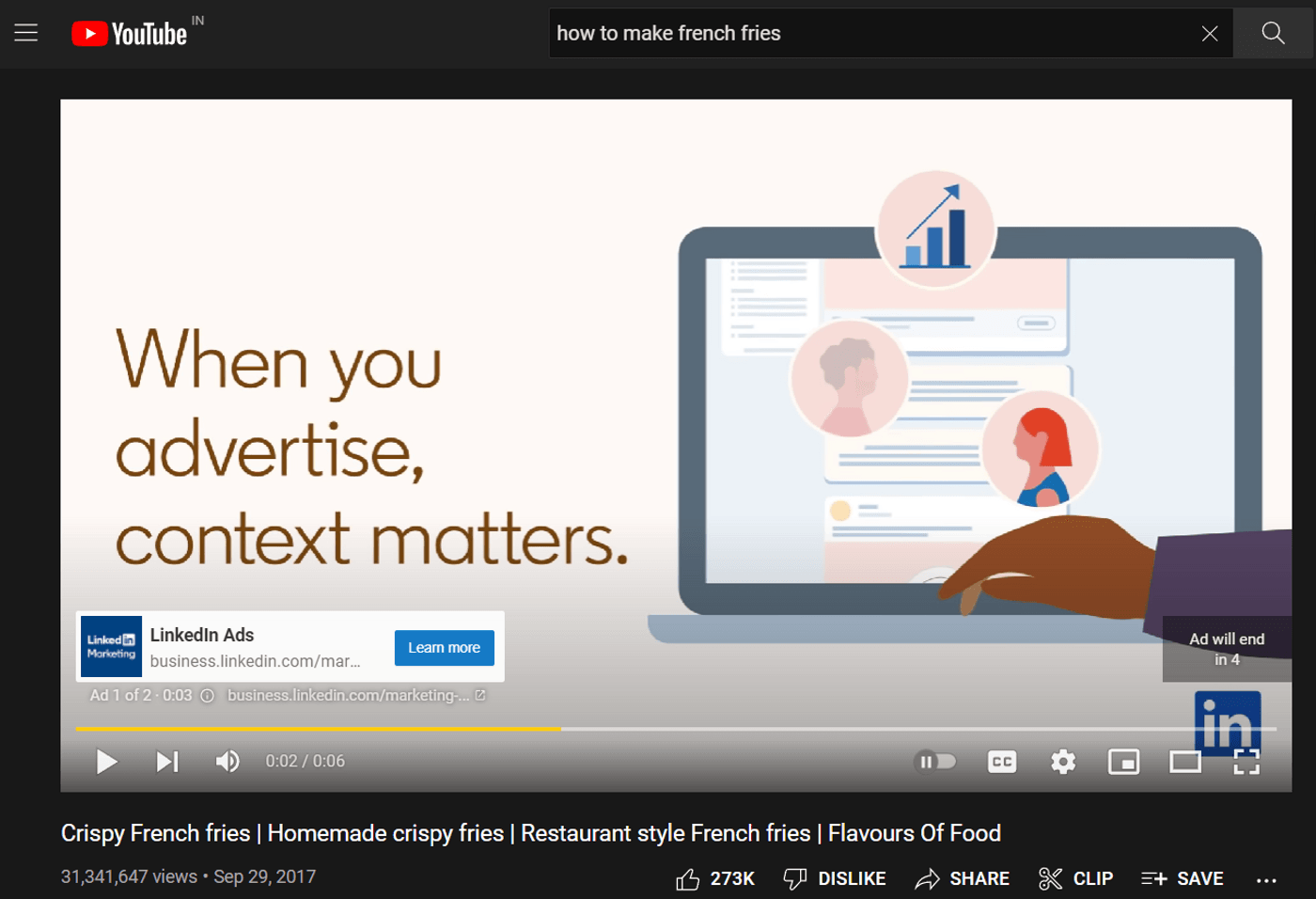
If you are just starting out with YouTube ads, you’ll first need to create a Google Adwords account. You don’t need a channel on YouTube to be able to advertise. You can use display ads on YouTube and set different audiences to advertise based on location. Wondering how to start advertising on YouTube? Here’s a detailed video on all you need to know about YouTube advertising.
Pro Tip: You can create high-quality YouTube ads using InVideo even if you have never edited a video in your life.
E. TikTok
TikTok has become the latest poster child for social media consumers and marketers. Short, funny, quirky videos and trending shots end up making a great recipe for marketers and online advertisers to join in. With more than 1 Bn active monthly users, TikTok offers limited advertising options. Advertising on TikTok is more about creating awareness and building a community. For instance, this Pepsi Max ad on TikTok shares information about a new product.
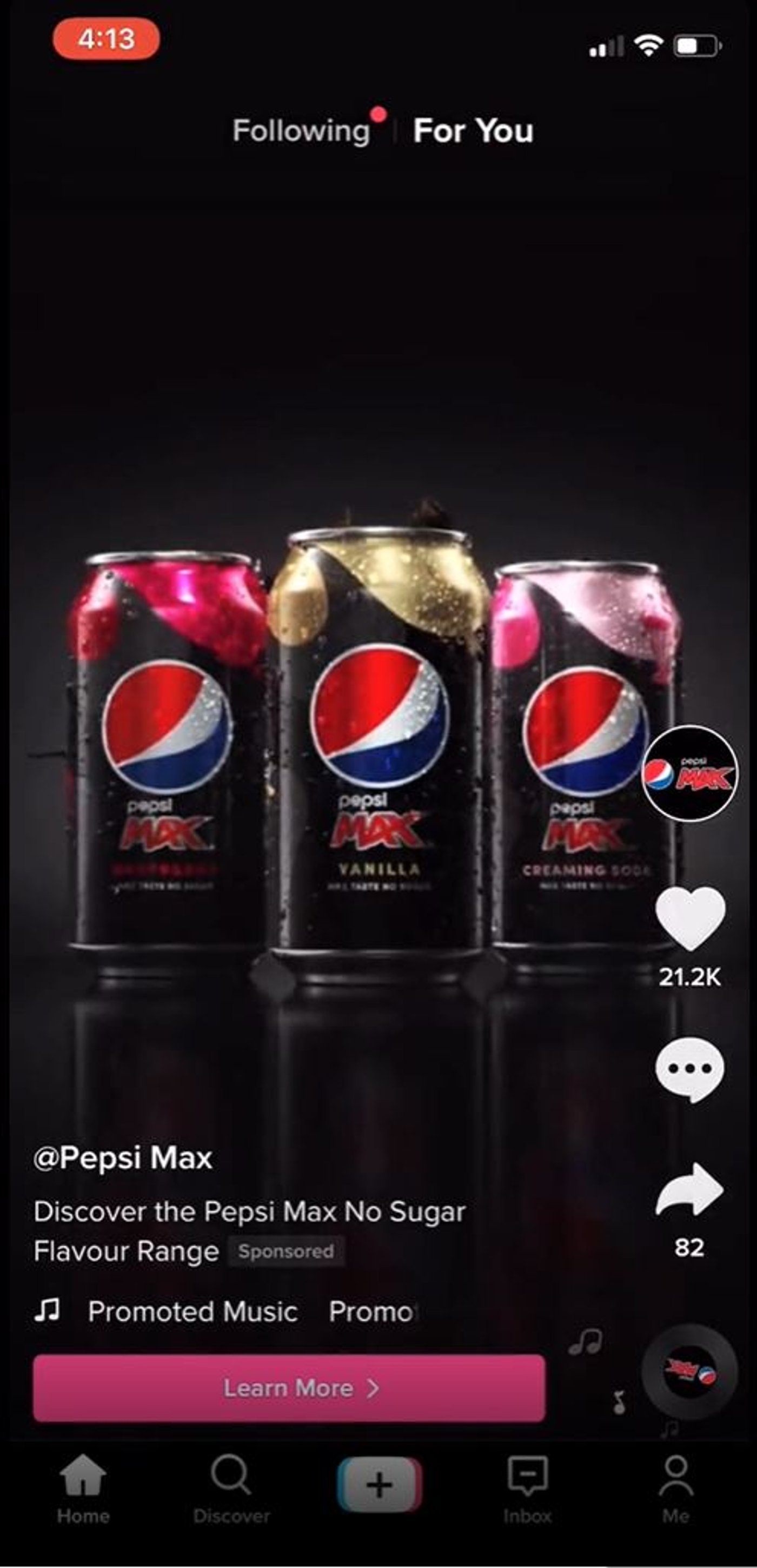
You can align your brand with popular TikTok trends and become a part of the conversation through dance challenges, memes, and even educational videos.
You can create a TikTok ad campaign through TikTok Ads Manager. TikTok lets you create targeted audiences for your ads. You have various ad options on TikTok including:
- Top view (a full-size video that shows when you launch the app)
- Brand takeover (an ad that takes over your entire screen when you launch TikTok)
- Infeed ads (ads that pop up when you’re scrolling through your TikTok feed- the most popular TikTok ad format)
- Branded hashtag challenge (hashtag challenges and trends stared by brands)
- Branded effects (effects and filters sponsored by brands)
Check out how to create your own TikTok ads by following this detailed video tutorial:
You can create a video ad on TikTok itself, but you have limited options to customize your ad. An alternative that provides you with more flexibility, InVideo offers you 5000+ templates to choose from and edit for your TikTok ad needs.
Now that we have seen the multiple types of online advertising channels, let’s take a look at some tips you need to keep in mind when creating your own online ad campaigns.
C. 7 Best online advertising strategies to use for your brand
What should your business do to become more successful in online advertising? Social media, especially goes through algorithm changes, so how can your brand future-proof marketing efforts and continue to earn ROI from your online advertising campaigns? Let us look at a few strategies you can use for online advertising.
1. Invest in online marketing
Online videos are predicted to make up more than 82% of all consumer internet traffic by this year. Clearly, you need to get started on video marketing right now. Whether you are creating video ads for social media or for other platforms, you are likely to experience higher engagement and greater conversions (also greater ROI). Video ads can help you build trust, credibility, and awareness. For example, check out this iPhone 13 ad.
Featuring the iPhone 13 in the hands of a naughty toddler, we see the iPhone falling down, falling into the sink, getting banged up, but it’s all okay. As the ad says, it’s toddler resistant. For parents with toddlers, this is a simple and effective way to prove the durability of the hardware (which was considered a weakness of most iPhones). Basically, the ad addresses the pain point many iPhone users might be concerned about, thus making it more accessible to parents with young kids (and everyone else who worries about dropping their iPhone).
If you want to make stunning, beautiful, and eye-catching video ads like this iPhone 13 ad, you need to figure out the most optimal way to address any pain points users may have with your products. Create a video script addressing a pain point for your users in a short and quick manner. Next, shoot your video based on your script. Next, utilize InVideo to edit your video, add relevant text, and you’ll have your own pro-quality video ad with minimal effort!
If you are a fitness or gym brand, start off with this ad encouraging people to try your products and services while addressing a current problem area related to fitness.
2. Create video ads for social media
Video posts on social media get 48% more views. If you are new to advertising on social media, you can start off with ads to boost brand awareness, engagement, and traffic. Consumers are today looking for authentic, real, behind-the-scenes content related to their favorite brands. To keep up with this need, you can create short and quick videos similar to Instagram Reels or TikTok videos. These videos can be simple, highly specific, and engaging. These can become video ads for different social media platforms. For instance, look at this Ikea Instagram video advertising their anti-slip mat.
This short ad draws your attention and gets you to stop scrolling through your Instagram feed with simple and relevant visuals. We don’t really see the product till the ad ends, but it’s still effectively advertised through the video and the caption.
Pro Tip: Create similar byte-sized, impactful video ads for social media using InVideo’s custom templates.
3. Know your target audience
While SEO and social media are great for digital marketing, your online advertising requires a concerted effort in targeting the right audience groups. No matter what platform you choose to advertise on, you get multiple choices in creating an audience that will consume your ads. Google, Facebook, Twitter, TikTok, Instagram, and YouTube, all offer you the option to choose specific target groups.
You can create audiences or cohorts based on interests, geography, and demographics (like age, gender, etc). Further still, studying the behavior of your users on your website or app, on social media, and more will allow you to know your audience more thoroughly.
Facebook, for example, allows you to target your audience based on up to 10 interests. Having a defined target audience, and knowing what they like to do and what they want lets you create the right ads across platforms that your audience frequents. Here’s an explainer video to understand how you can find your audience on social media.
4. Run pay per click ads
PPC or pay-per-click advertising campaigns allow you to pay Google to display your ads at the top of the search results. PPC campaigns are effective for your business in various ways. When PPC works right, the fee you pay is smaller compared to the benefits you’ll receive. For example, you may have paid $3 for a click, but the click may result in a $500 sale, thus making you a large profit.
As mentioned before in this article, PPC campaigns require various steps to start with. You need to research the right keywords, set up your budget, bid for various keywords, select your target audiences, and more. The more relevant ads you create, the more Google ensures that your webpages, videos, and ads rank on the search engine. If your ads create value for users, Google also charges you less per click, increasing your ROI from the ad campaign. If you want to start off your PPC journey, you need to create a Google ads account and link your website to it. Check out this video to start off with your own PPC campaign on Google.
And make sure that you are also creating video ads for your PPC campaigns. You can take the help of an easy-to-use editor like InVideo to create these ads within minutes and get substantially more ROI.
5. Optimize your website for search engines
SEO or search engine optimization is all about helping your content rank higher on search engines. When people search for something on Google (or other search engines and platforms), you want to make sure that your brand is visible if relevant. To achieve this, you need to make sure that all your digital assets, including websites, web pages, ads, and videos are optimized with the right keywords. You need to make sure that target keywords (that people are likely to search for on Google) are written in the content of your website and ads.
For example, when I search the keyword ‘dentists in Seattle,’ the following results show up.
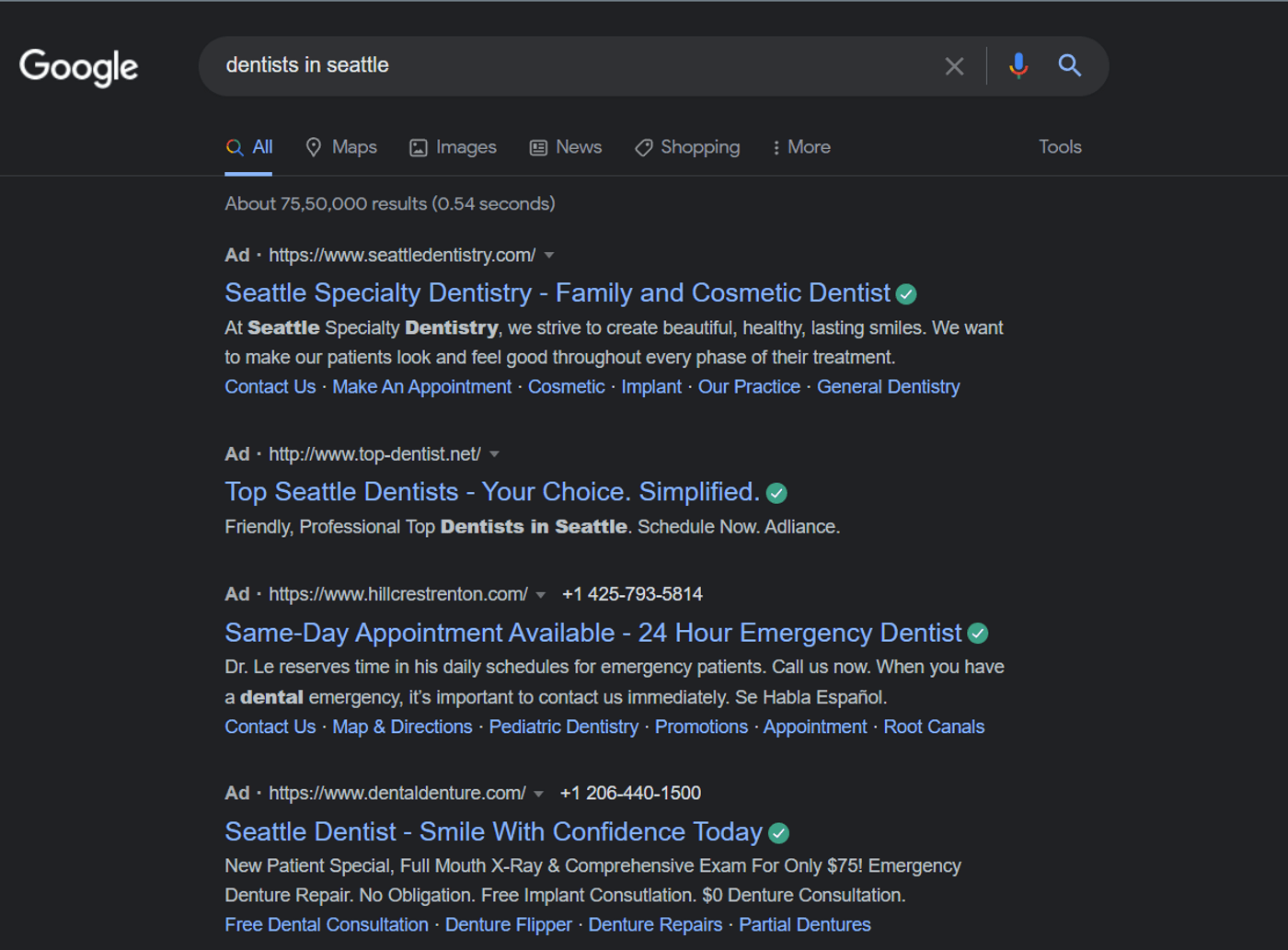
All the top 4 search results are ads that are optimized to use the keywords dentists, Seattle, dentistry, and more. You can optimize your content for search engines in a similar manner, sprinkling relevant keywords across your ads, social posts, and website. You’ll also need to make sure you update this content from time to time.
You can also use other methods like optimizing and increasing the page load time for your website and making it friendly for mobile interfaces. These strategies will increase your rankings since Google will recognize that they improve the user experience.
Check out this detailed guide on SEO to start your own search engine optimization practices. If you are creating video ads, here is a look at how you can optimize your video for search engines too!
Pro Tip: Adding videos to your website can also help your SEO score significantly. Create videos for your website easily and quickly using InVideo's video editor.
6. Collaborate with popular publications for native ads
Native advertising is one of the most immersive ad experiences we can make use of today. For online advertising, this translates into text and video content. Brands can partner up with publishers or other brands to promote their content more effectively. As an added bonus, editorial expertise, thought leadership, and brand vision all merge together to create ads that have a different type of impact. Social media sites have in-feed native ads while Google Search also promotes native ads as listings that appear at the top or in the sidebar.
Native ads build credibility and trust, while at the same time promoting a product or a service. For instance, check out this native video ad in the Financial Times featuring students from the Technical University in Valencia, Spain who were competing in the 2018 Hyperloop Pod Competition run by Elon Musk's SpaceX company.
The ad tells the story of the Hyperloop Pod competition as well as the students from Spain working on designing a pod. Though it is a promoted feature or an ad, the video also shares relevant information for readers of the Tech section in the Financial Times. Being presented as a news story, this video combines various elements like video, storytelling, beautiful shots, and relevant content to create an ad that doesn’t really seem like an ad. Native ads can be highly engaging and hyper-targeted towards specific users or consumers, with a high chance of conversion.
There are 3 main types of native ads:
- Infeed ads (ads that appear to be a part of the feed)
- Content recommendation ads (these are content recommendations you see on the sides of the webpage or after reading an article on a website)
- Branded content ads (these are special ad features that are done by the brand in collaboration with the publisher)
Native ads can take many forms. For example, in 2017, Netflix partnered up with Spotify to create a unique type of native ad to promote Stranger Things. They created an exclusive playlist and let users turn on the Stranger Things mode on Spotify to immerse into the world of Stranger Things.
While creating unique experiences may take some time and effort, you do have the option to create impactful video native ads to start off with InVideo, even if you have never edited a video before. Create your own native ads by pitching deep, insightful, thought leadership content to publishers following this guide.
7. Optimize product listings
Product listing ads are ads that people see when they search for a specific product on Google or Instagram or other platforms. The goal is to ensure that your product listing ads have all the relevant information that helps a prospective consumer make the decision to buy. You want to provide all the relevant details upfront so that they can compare prices, specifications, etc while watching your listing ad itself.
For example, when I search for a ‘white shirt for women,’ the product listing ads tell me the name of the retailer, the price, the picture, and other details about the product. This helps me know exactly how the product looks.
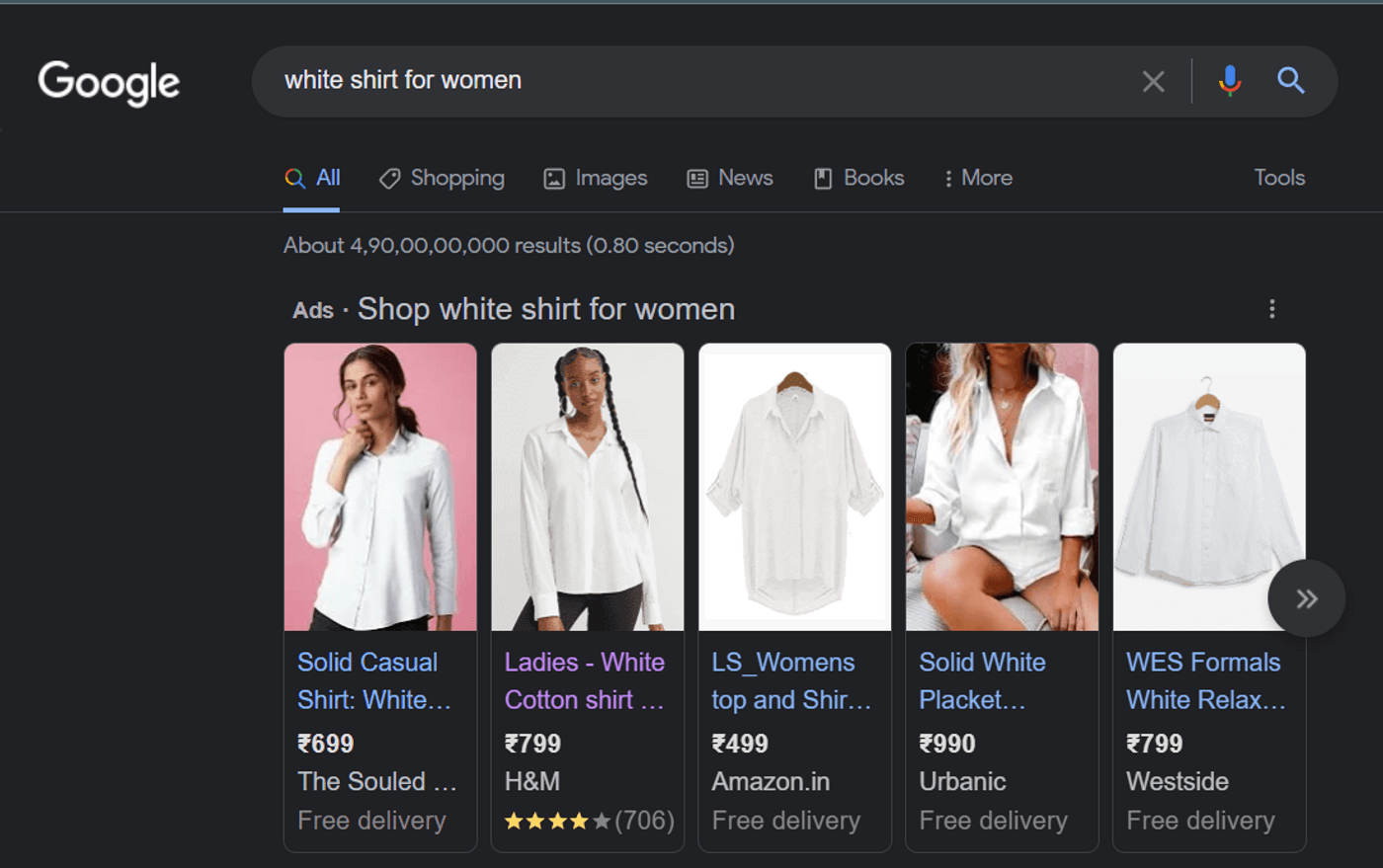
You need to ensure that your brand pays attention to your product feed on your website or online shop. This way, PLAs or product listing ads on Google will display complete information.
A great online advertising campaign is all about integrating your ad efforts across platforms and analyzing performance data regularly to upgrade your results. Now that you know these basics, get started on creating your own online ads right away!
Wrapping Up
An effective ad will be one that grabs attention, showcase the utility of the product or service, and is remembered by the audience long after they’ve seen it. This list of online advertising platforms and strategies we’ve shared should help you get closer to the goal of creating such impactful ads.
Meanwhile, if you are an e-commerce brand looking to level up, check out this comprehensive guide. If you are looking for ways to advertise your business for free, have a look at this detailed article.
And if you prefer learning via videos, you definitely should check out our YouTube channel where we share daily video creation tips and tricks, the latest video trends and ideas, and help you make more money as a video creator.
Finally, if you’re looking to create thumb-stopping videos in minutes (even if you’re not a PRO)- sign-up for a free account on InVideo.io today.
This post was written by Upasna and edited by Adete from Team InVideo


